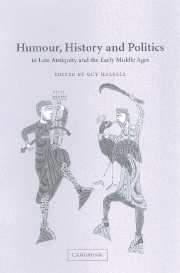Book contents
- Frontmatter
- Contents
- Notes on contributors
- Preface
- List of abbreviations
- Introduction: ‘Don't worry, I've got the key’
- PART I THE FATE OF HUMOROUS WRITING
- PART II HUMOUR AND THE POLITICS OF DIFFERENCE
- PART III HUMOUR, HISTORY AND POLITICS IN THE CAROLINGIAN WORLD
- 6 ‘He never even allowed his white teeth to be bared in laughter’: the politics of humour in the Carolingian renaissance
- 7 Alcuin's Disputatio Pippini and the early medieval riddle tradition
- 8 Laughter after Babel's fall: misunderstanding and miscommunication in the ninth-century west
- Index
8 - Laughter after Babel's fall: misunderstanding and miscommunication in the ninth-century west
Published online by Cambridge University Press: 24 July 2009
- Frontmatter
- Contents
- Notes on contributors
- Preface
- List of abbreviations
- Introduction: ‘Don't worry, I've got the key’
- PART I THE FATE OF HUMOROUS WRITING
- PART II HUMOUR AND THE POLITICS OF DIFFERENCE
- PART III HUMOUR, HISTORY AND POLITICS IN THE CAROLINGIAN WORLD
- 6 ‘He never even allowed his white teeth to be bared in laughter’: the politics of humour in the Carolingian renaissance
- 7 Alcuin's Disputatio Pippini and the early medieval riddle tradition
- 8 Laughter after Babel's fall: misunderstanding and miscommunication in the ninth-century west
- Index
Summary
‘How many languages are there? Seventy-two.’ Thus ran the pithy treatment of the diversity of human tongues present in several eighth- and ninth-century collections of Ioca monachorum, ‘Monkish jokes’. Like early medieval wisdom dialogues, the Ioca were written to entertain and to educate, playfully testing biblical knowledge through riddling questions. On one level they serve as a reminder that a close relationship between levity and the classroom continued to exist long after schoolboys were amused, to Jerome's annoyance, by the testament of the piglet ‘Grunnius Corocotta’, and long before Peter Abelard's joking syllogisms elicited the laughter of his Paris students and the comparably cool comment of Otto of Freising. More specifically, this particular question, ‘how many languages are there?’, encapsulates the themes I wish to discuss here, for the answer, ‘seventy-two’, originates in patristic exegesis on Genesis 10–11. This is, of course, the well-known account of the building and subsequent destruction of the Tower of Babel, the ‘scattering of peoples’ that followed in its wake and, with this, the creation of the ‘confusion of tongues’ that offered early medieval intellectuals an explanation for the multiplicity of earthly languages.
As Arno Borst has shown in exhaustive detail, Babel stood at the centre of scripturally based explanations of the diversity of human culture and language. Differences in speech, and the incomprehensibility of the language of one people to another, occupied the very core of the antique notions of ‘the barbarian’, which continued into the early Middle Ages.
- Type
- Chapter
- Information
- Publisher: Cambridge University PressPrint publication year: 2002
- 1
- Cited by



